 It’s official. We’re in the middle of a fierce wireless price war by national wireless carriers. AT&T, Sprint, T-Mobile, and Verizon have all introduced new plans, undercutting each other in the past few weeks, with more to come.
It’s official. We’re in the middle of a fierce wireless price war by national wireless carriers. AT&T, Sprint, T-Mobile, and Verizon have all introduced new plans, undercutting each other in the past few weeks, with more to come.
This war impacts wireless and wireline carriers alike. By lowering prices, these national carriers not only entice wireless customers to switch carriers, but wireline customers to cut the cord.
Wireless Price Wars
So what should smaller carriers do, besides take cover? Here are a few ideas:
- Remain competitive, but don’t get caught up in a race to zero – As larger carriers cut prices, all competitors need to evaluate their pricing structure to ensure a level of competitiveness. But that doesn’t mean try to match these offers dollar for dollar. Remaining competitive doesn’t always mean matching or undercutting competitor offers. It simply means providing great value for the price and getting creative with offers and promotions. It’s always healthy to tinker with pricing models to ensure customers continue to perceive value in your offer.
- It’s worth repeating, local does matter – Customers don’t like higher prices, but they hate when they are treated “like a number” even more. Larger carriers are distracted in smaller markets. They have no choice but to treat customers as a number, rather than a human being. Very little local presence (if any) and long hold times for customer service are common characteristics. In times like these, where pricing is being used as a weapon, reaffirming local presence and ties to the community are even more important. Ensure your long standing local presence and great customer service receives renewed emphasis.
- Technology does matter, work hard to stay relevant – National carrier marketing campaigns and the prevalence of social media and other tools ensures most customers understand the value of advanced 4G technology. Carriers who can’t provide a comparable experience risk losing relevance. Smaller carriers should explore all options to ensure their network keeps pace and remains relevant to all subscribers. That may mean partnering with technology and operations experts who can lower costs and help mitigate risk for the 4G networks necessary to remain relevant. Indeed for many smaller wireless carriers, it may be the only long term option.
- Don’t work harder, work smarter – It’s easy to think you can outwork your competition. But in a 4G environment, where the pace of innovation and technology change are frenetic, and wireless carriers collectively spend $billions (yes billions) on marketing, working smarter is the only solution. That means finding the right partners and leveraging collective mindshare for mutual success. Going it alone is a very difficult proposition in a normal environment. In current and future pricing wars, it may be impossible.
These ideas are good practices during any environment, but they have renewed meaning in today’s price war environment. At NetAmerica Alliance, we’re committed to ensuring our Members can not only withstand today’s pricing wars, but build and operate sustainable rural 4G LTE networks for the long term.
To learn more about how to position yourself for success, visit us at the upcoming CCA conference in Vegas where I will be speaking on how to market your organization with limited resources.
Interested in publishing a sponsored post to Telecompetitor? Contact us or call 240-450-2161.


